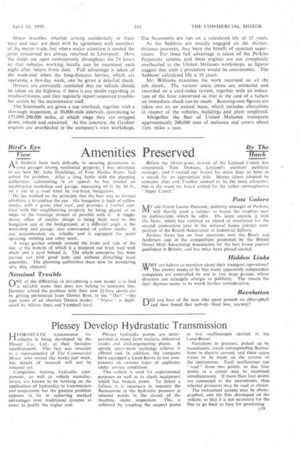Plessey Develop Hydrastatic Transmission
Page 57

If you've noticed an error in this article please click here to report it so we can fix it.
LJYDRASTATIC transmission for vehicles is being developed by the Plessey Co., Ltd., at their Swindon establishment. This fact was revealed to a representative of The Commercial Motor who visited the works last week, but details of research will not be released yet.
Companies making hydraulic components, as well as vehicle manufacturers, are known to be working on the application of hydraulics to transmission and suspension, but the greatest problem appears to lie in achieving marked advantages over traditional systems in order to justify the higher cost.
Plessey hydraulic pumps are incorporated in many farm tractors, industrial trucks and civil-engineering plants. A speedy spare-parts exchange scheme is offered and, in addition, the company have equipped a Land-Rover to test components on various types of appliance under service conditions.
This vehicle is used for experimental purposes as well as to check equipment which has broken down. To detect a failure, it is necessary to measure the fluctuations in the hydraulic pressure at selected points in the circuit of the machine under inspection.' This is achieved by coupling the suspect pump to two oscilloscopes carried in the Land-Rover.
Variations in pressure, picked up by transducers, create corresponding fluctuations in electric current, and these cause traces to be made on the screens of the instruments.. Each oscilloscope can " read" from two points, so that four points in a circuit may be examined 'simultaneously. If more than four points are connected to the instruments, then selected pressures may be read at choice.
The instrument screens may be photographed, and the film developed on the vehicle, so that it is not necessary for the film to go back to base for processing.












































































































